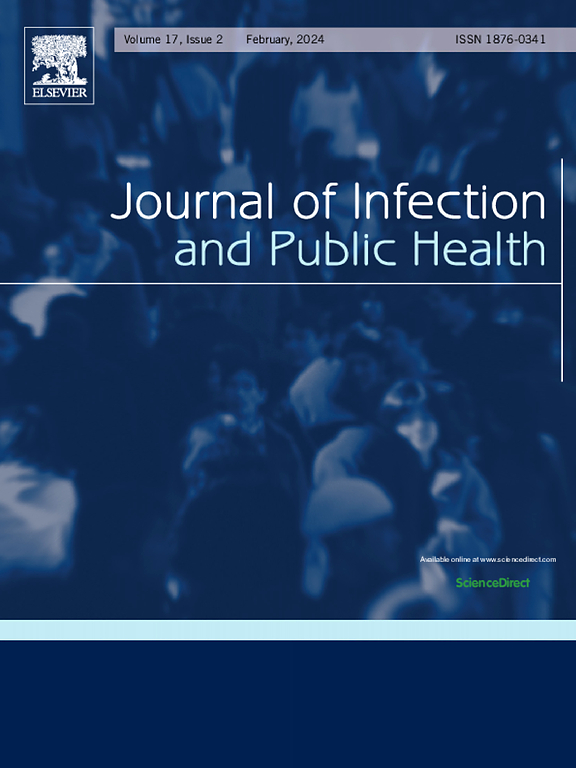危重感染儿童的真实世界病原体诊断:采用不同富集策略的新一代宏基因组测序的回顾性研究
IF 4
3区 医学
Q1 INFECTIOUS DISEASES
引用次数: 0
摘要
背景使用不同富集策略的宏基因组新一代测序(mNGS)在大队列危重儿童临床病原体诊断中的研究有限。方法对763份样本进行临床病原菌诊断总结,比较不同样本类型的mNGS与临床微生物检测(cmt)、霰弹枪法(S-mNGS)与混合捕集法(C-mNGS)的性能。结果763份疑似感染标本共检出临床诊断病原菌93种,阳性率为60.16 %。呼吸道标本阳性率最高(90.73 %,235/259),脑脊液阳性率最低(26.94 %,59/219)。西班牙芒果显示更高的灵敏度(90.85 % 83.66 vs % P = 0.001),特异性(77.30 % 67.43 vs % P = 0.007),阳性预测值(PPV 85.80 % 79.50 vs % P = 0.01),阴性预测值(NPV, 84.84 % 73.21 vs %,P & lt; 0.001),和准确性(85.45 % 77.20 vs % P & lt; 0.001)比cmt。mNGS的校正真阳性率高于CMTs(83.88 % vs. 75.60 %,P = 0.002),在病毒检测方面的优势更为明显(OR=1.39, 95 %CI: 1.08-1.78, P = 0.010)。S-mNGS和C-mNGS的灵敏度和准确性均显著高于cmt。S-mNGS和C-mNGS的总真阳性率接近(83.15 % vs. 85.00 %,P = 0.600)。mNGS结果显示,调整后的病原菌诊断率为45.48 %(417/763),调整后的抗感染策略率为42.86 %(327/763)。结论ngs为疑似感染的危重患儿提供了一种有效的病原体诊断方法。不同的mNGS富集策略可以在临床实践中发挥各自的优势。本文章由计算机程序翻译,如有差异,请以英文原文为准。
Real-world pathogen diagnosis in critically ill infected children: A retrospective study using metagenomic next-generation sequencing with different enrichment strategies
Background
Study on the clinical pathogen diagnosis in large cohort of critically ill children using metagenomic next-generation sequencing (mNGS) with different enrichment strategies has been limited.
Methods
763 samples were enrolled and we summarized the clinical pathogen diagnosis and compared the performance between mNGS and clinical microbial tests (CMTs) in different sample types, as well as between shotgun-based (S-mNGS) and hybrid capture-based mNGS (C-mNGS).
Results
A total of 93 clinical diagnosed pathogens were identified from763 samples with suspected infections, with a positive rate of 60.16 %. Respiratory specimens had the highest positive rate (90.73 %, 235/259), while the lowest was cerebrospinal fluid (26.94 %, 59/219). mNGS showed higher sensitivity (90.85 % vs. 83.66 %, P = 0.001), specificity (77.30 % vs. 67.43 %, P = 0.007), positive predictive value (PPV, 85.80 % vs. 79.50 %, P = 0.01), negative predictive value (NPV, 84.84 % vs. 73.21 %, P < 0.001), and accuracy (85.45 % vs. 77.20 %, P < 0.001) than CMTs. The corrected true positive rate of mNGS was higher than CMTs (83.88 % vs. 75.60 %, P = 0.002), and its advantage in virus detection was more obvious (OR=1.39, 95 %CI: 1.08–1.78, P = 0.010). S-mNGS and C-mNGS shown significantly higher sensitivity and accuracy than CMTs. However, the total true positive rate between S-mNGS and C-mNGS were close (83.15 % vs. 85.00 %, P = 0.600). According to the mNGS results, the adjusted pathogen diagnosis rate was 45.48 % (417/763), and the adjusted anti-infection strategy ratio was 42.86 % (327/763).
Conclusions
mNGS provided an efficient pathogen diagnosis method for critically ill children with suspected infection. Different enrichment strategies of mNGS can play their respective advantages in clinical practice.
求助全文
通过发布文献求助,成功后即可免费获取论文全文。
去求助
来源期刊

Journal of Infection and Public Health
PUBLIC, ENVIRONMENTAL & OCCUPATIONAL HEALTH -INFECTIOUS DISEASES
CiteScore
13.10
自引率
1.50%
发文量
203
审稿时长
96 days
期刊介绍:
The Journal of Infection and Public Health, first official journal of the Saudi Arabian Ministry of National Guard Health Affairs, King Saud Bin Abdulaziz University for Health Sciences and the Saudi Association for Public Health, aims to be the foremost scientific, peer-reviewed journal encompassing infection prevention and control, microbiology, infectious diseases, public health and the application of healthcare epidemiology to the evaluation of health outcomes. The point of view of the journal is that infection and public health are closely intertwined and that advances in one area will have positive consequences on the other.
The journal will be useful to all health professionals who are partners in the management of patients with communicable diseases, keeping them up to date. The journal is proud to have an international and diverse editorial board that will assist and facilitate the publication of articles that reflect a global view on infection control and public health, as well as emphasizing our focus on supporting the needs of public health practitioners.
It is our aim to improve healthcare by reducing risk of infection and related adverse outcomes by critical review, selection, and dissemination of new and relevant information in the field of infection control, public health and infectious diseases in all healthcare settings and the community.
 求助内容:
求助内容: 应助结果提醒方式:
应助结果提醒方式:


